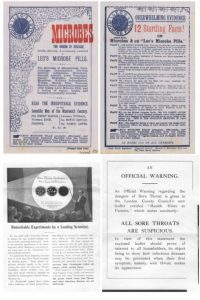By Rosemary Lim (Pharmacy)
What do graphic and information design, architecture, pharmacy and human factors have to offer collectively to tackle antimicrobial resistance (AMR)?
We are very excited to report that a multi-disciplinary team of academics who are members of the Health Humanities research cluster in the disciplines mentioned and Loughborough Design School have recently been successful in receiving funding from the Arts and Humanities Research Council special call on tackling antimicrobial resistance in the build environment.
The Information Design and Architecture in Persuasive Pharmacy Spaces: combating AMR [IDAPPS] project, led by Professor Sue Walker (Typography and Graphic Communication), introduces ‘persuasive space’ in thinking about the presentation of information, its situation within an environment, and how users interact with it, in the context of a community pharmacy. Community pharmacies are socially inclusive and convenient, and today play a key role in delivering public health. They are places where people wait for prescriptions to be filled or to see a pharmacist, and offer a persuasive space to raise awareness of the dangers of AMR.
The work done by Otto and Marie Neurath in the 1930s to raise awareness of and support prevention of tuberculosis (TB) inspired our work. They produced a series of charts with striking and effective images based on consistent and carefully considered principles, for public display in schools and community centres. The Neuraths believed that the space in which the charts were read and used was important for their effective reception and understanding. This aligned with the notion of persuasive space in architecture, in particular a significant seam of work taking place in the 1930s in the early stages of modernism when functionalism came to the fore.
IDAPPs considers this historical context studying graphic and information design in the nineteenth- and early-twentieth century used to tell people about, for example, TB, infection spread, and approaches to hygiene to combat bacterial infection. We use this information to inform ideas for the development of designs for a persuasive pharmacy space, also taking account of user-centred information design projects which patients, families, carers, health professionals and designers work together, and the integrating and participatory principles of human factors and ergonomics.
IDAPPS has been designed to provoke and to generate ideas for future consideration. Through a competition, good practice report, and public exhibition, we anticipate a thriving legacy. A competition to design persuasive pharmacy space will comprise teams of information/graphic designers, architect or built environment professionals or researchers and pharmacy practitioners or researchers. It will result in the development of a winning prototype set up in a pharmacy.
A report containing good practice guidelines for persuasive space in community pharmacies will contribute to expanding knowledge on the impact of the built environment and information design on wellbeing and education and will therefore be of interest to a wide variety of organisations. An exhibition will show examples of archival material to show how explanations and descriptions of AMR have been dealt with in the past, and the prototype design solutions.
To enhance feasibility and add value to the project, we have engaged two project partners: Day Lewis, a large independent pharmacy chain and Design Science, a leading science communication design group who will advise on the transformation of scientific fact to understandable information and play a key role in the curation and design of the exhibition.
Academic team
University of Reading
Prof Sue Walker (PI) Typography & Graphic Communication; Dr Rosemary Lim (Co-I) Pharmacy; Prof Flora Samuel (Co-I) Architecture
Loughborough University
Prof Sue Hignett (Co-I) Loughborough Design School

Examples of late-19th and early-20th century printed ephemera selected to how information about ‘microbes’ was presented to the public. Our intention is to focus on the verbal and graphic presentation of the information, noting, for example, expected level of literacy of the readers; ways in which medical authority is conveyed, and how the idea of microbes and resisting their spread has been represented graphically.


